________________ JAINISM IN ROYAL FAMILIES About Samprati's zeal for the Jaina church Hemacandra bricfly observes as follows: "He showed his zeal by causing Jaina temples to be erected over the whole of Jambudvipa. During Sulastin's stay at Ujjaini, and under his gudance, splendid re ligious festivals and processions in honour of the Arhat were cele* brated, and great was the devotion manifested by the king and his subjects on this occasion. The example and advice of Samprati induced his vassals to embrace and patronise his creed, so that not only in his kingdom but also in adjacent countries the monks could practise their religion "1 What is more important for us to know in connection with Samprati is this--that he sent Jama missionaries to South India, and that these were of the Svetambara persuasion. To quote Hemacandra: "In order to extend the sphere of their (Jaina monks) activities to uncivilised countries, Samprati sent there messengers disguised as Jaina monks. They described to the people the kind of food and other requisites which monks may accept as alms, enjoining them to give such things instead of the usual tax to the revenue collector who would visit them from time to time. Of course these revenue collectors were to be Jaina monks. Having thus prepared the way for them, he induced the superior to send monks to those countries, for they would find it in no way impossible to live there. Accordingly missionaries were sent to the Andhras and Dramilas, who found everything as the king had told. Thus the unciylised nations were brought under the influence of Jainism." S The importance of the Jaina missionaries sent by Samprati to uncivilised countries, as Hemacandra tells us, lies in this that it is the carliest reference, so far as we know, to contact of the Svetambaras with the south. Hence it is as important as the great migration dealt with in this and the preceding chapter. We particularly call it the Svetambara contact because, as seen before, the Svetambara-Digambara schism in the Jaina church is connected with both the migration and the Subastin-Mahagiri tradition. That Jauna temples or monuments of unknown ongin are ascribed by the popular voice to Samprata, who is in fact regarded as a Jaina Asoka " Sraith, Early History of India, P 202 1 Jacobi, op at, p 69. * Cf Bhandarkar, op and loc ct About this the Pataliputrahalpa of Jmaprabhasura observes "In Pataliputra flourished the great King Samprati, son of Kunala, Iord of Bharata with its three continents, the great Arhanta who established Viharas for Sramanas even in non-Aryan countries"--cf Raychaudhuri, op art, p 222. * Cf. Jacobi, op and loc cit 145




